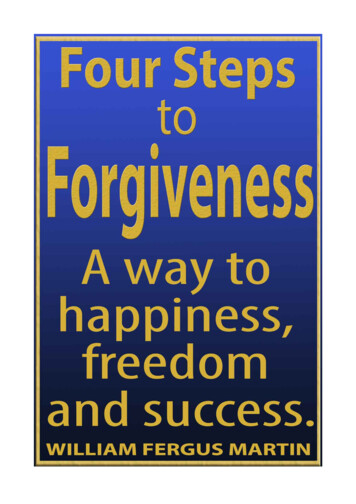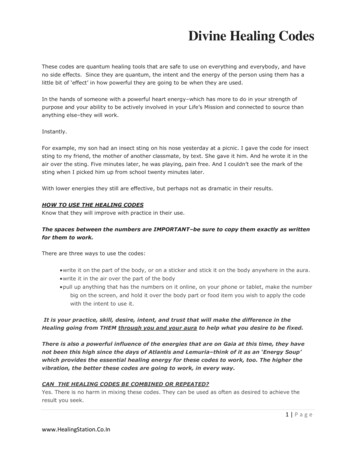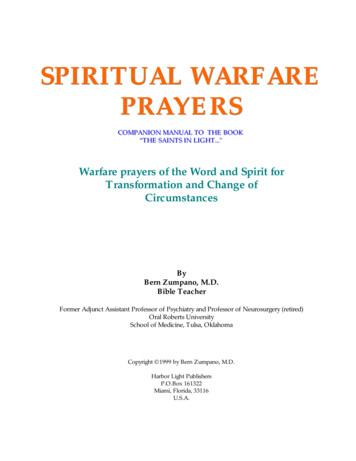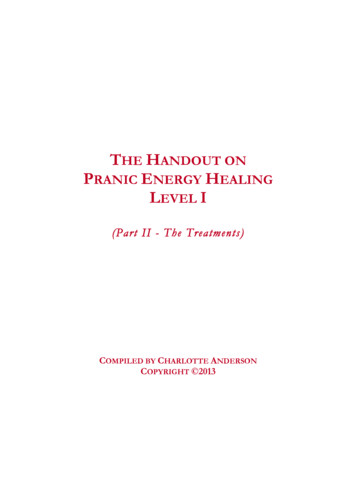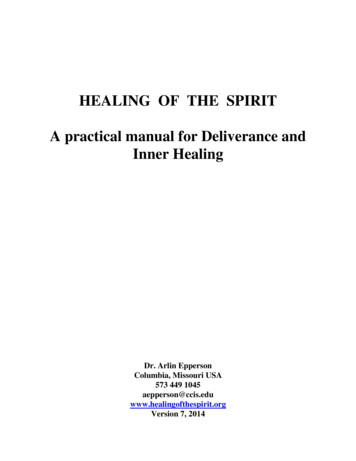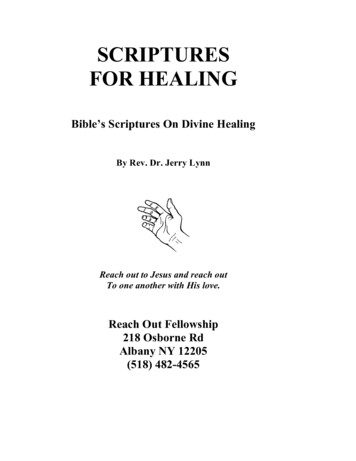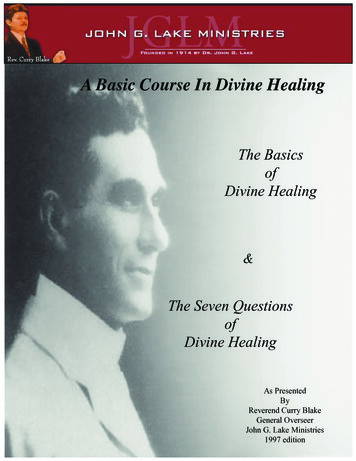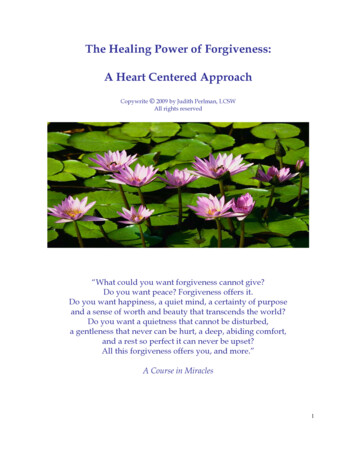
Transcription
The Healing Power of Forgiveness:A Heart Centered ApproachCopywrite 2009 by Judith Perlman, LCSWAll rights reserved“What could you want forgiveness cannot give?Do you want peace? Forgiveness offers it.Do you want happiness, a quiet mind, a certainty of purposeand a sense of worth and beauty that transcends the world?Do you want a quietness that cannot be disturbed,a gentleness that never can be hurt, a deep, abiding comfort,and a rest so perfect it can never be upset?All this forgiveness offers you, and more.”A Course in Miracles1
CHAPTER IAN INTRODUCTION TO FORGIVENESSAs a psychotherapist specializing in health psychology for over twentyyears, I’ve come to understand that in order to live fully and joyfully in thepresent, it is absolutely necessary to release the pain that we all carry withus from the past. Without the power of forgiveness to help us heal, thepast has the potential to destroy our present lives. Giving up the past isnot easy -- but it is one of the keys to a rewarding life.When you release the past you reclaim your power.We’re all wounded. People who have lived life with any depth haveexperienced loss and disappointment. We all have limited life-energy.When our life-energy is directed to the past, we have less energy to live inthe present. When we release the past, we have more power to heal, to selfactualize, to become whole – to live a full and satisfying life.I have yet to meet the person who hasn’t experienced some kind of hurt orpainful trauma during their lifetime. But why would any of us want toforgive someone who had deliberately hurt us? What would be thebenefit? How does the lack of forgiveness harm us?The experience of being wounded, and what happens to oneas one responds to the wound, gives us the wisdom to heal our selvesand one another. -- Dr. Rachel Naomi Remen2
Scientists tell us that emotions such as sadness, anger, guilt andresentment, if chronic, can damage us mentally, physically and spiritually.They can interfere with our relationships at work and at home. They canaffect our overall sense of well-being.I’ve been investigating the topic within the fields of psychology andspirituality for over two decades. I began my interest in forgiveness toachieve peace of mind. Only later did I learn the powerful healing effects offorgiveness on the body, mind and spirit. Not only will forgiveness offerpeace of mind and improve your physical health, but learning to forgivecontributes to your level of consciousness and self-awareness by bringinghigh frequency subtle energies into your heart center.The lack of forgiveness is dangerous. Current research shows that negativeemotions can trigger an avalanche of stress hormones that can accelerateheart rate, shut down the immune system, and increase our chances ofdeveloping serious illnesses. An abundance of research documents theharmful effects of anger and resentment on the body. Someone once saidthat “holding a grudge is like taking poison and expecting your enemy toget sick."“By far the strongest poison to the human spiritis the inability to forgive oneself or another person.It disables the person’s emotional resources .When we refuse to forgive we sit in a prison of toxic emotions”.Carolyn MyssSince 1997 I’ve conducted numerous forgiveness workshops forindividuals from all walks of life. Some came to learn self-forgiveness.3
Others worked to forgive loved ones, friends, co-workers, caregivers,deceased family members and even God.Their grievances ran the full gamut – betrayal, marital infidelity, violence,incest, verbal and emotional abuse, and the existential feelings of regretthat come with catastrophic illness and end of life. But, research has shownthat no matter how awful the offense, the ability to forgive can be learnedPractically all of us have the capacity for forgiveness. We can all seeourselves forgiving some small slight, some little offense ormisunderstanding. We tend to think that major offenses are“unforgivable.” But our ability to forgive is much greater than we think.I’ve watched as clients moved from hurt and anger to compassion andpeace. I watched them work through guilt and regret and develop prideand self-acceptance. I’ve watched numerous individuals with the selfimage of Victim become spiritual warriors and Victors as they continued towork with the process of forgiveness.It’s understandable that we’re fearful of giving up our wounds, because itmeans change. But remember: we can’t be a victim and also beempowered. We can’t live our lives filled with guilt or in hope of revenge,because this fills us with negative emotions and continues the otherperson’s power over us. We can’t burden ourselves with chronic sadness,anger, resentment and guilt, and still expect peace of mind. We can’t beembittered and expect healthy, successful relationships.Although we may not be responsible when a bad thing happens to us, weare in control of our long-term attitude about what happened. It is really4
our choice. Forgiveness does not “undo” the actions of the past – but itdoes recognize that we can use the past to grow.Forgiveness is a personal act. It is a sign of strength – of our inner power toturn our hearts from malice to love, from resentment to understanding –and then to move on. When we decide to forgiven, we begin to learn thatwhen we or others behave badly, it is because of deep feelings of pain.And when we learn to understand the pain and forgive the transgressionsof others, we can forgive ourselves more easily. To forgive is not to excusehurtful behavior; it is to recognize that despite hurtful behaviors, theperson who behaved badly still has intrinsic worth just by virtue of the factthat he/she is a human being and that at the soul level – we are all brothersunited in the Source of life itself.“Forgiveness is giving up the possibility of a better past.”CHAPTER IIWHAT IS REQUIRED TO FORGIVE?5
Researchers and writers on forgiveness generally agree that we must bewilling to undertake five mental tasks:(1) We must understand the true meaning of forgiveness.Forgiveness is not about who is right or wrong;condoning hurtful behavior;forgetting the offense;surrendering our right to justice;being a victim;absolving the hurtful behavior;pretending the hurtful behavior didn’t occur;loss of power;getting the other person to do something different;self-righteousness, superiority or pity.Forgiveness is a gift we give ourselves to achieve peace of mind; freedom from the past; a decision to live in the present moment; recognition that we have a choice about our thoughts; self-respect; strength and empowerment connecting to our spiritual, loving self.Remember, our act of forgiveness doesn't mean that we condone or absolvethe hurtful behavior -- or that we're forgetting about it. Forgiveness doesn'trequire us to reconcile with the offender or to get him or her to dosomething different.6
Forgiveness does mean recognizing that we have a choice about ourperceptions and our thoughts -- and that we are choosing peace of mind.Forgiveness means freeing ourselves from the past and choosing to live inthe present moment.choosing empowerment over victim-hood.andchoosing to connect to our spiritual, loving selves.(2) We must be willing to let down our defenses.It’s difficult to experience the full intensity of our feelings. Of course, noneof us like to feel vulnerable -- but we can’t let go of emotions that wehaven’t first acknowledged.(3) We must be willing to give up the need for vindication or revenge.It's natural to want retribution, and we usually don’t give up the need forrevenge until we realize that it hasn’t worked -- and is not going to work.Old Chinese Proverb“The one who pursues revenge should dig two graves.”Sometimes we hold on to hurt and anger in the hope that we willultimately get the offender to admit wrong or to change. We must give upthat hope if we are to achieve the peace of mind that comes withforgiveness.When we are working to forgive ourselves there are many challenges to befaced. In order to admit wrong, we must let down our defenses, andfeelings of vulnerability may arise. All of us are generally protective of ourself-image. Giving up a self-image of innocence can feel threatening. Wemay erroneously believe that to admit wrongdoing will jeopardize oursense of worth – and we may defend against it.7
To admit to another that we are wrong may result in a loss of status orpower in the relationship. And, we may avoid admitting wrongdoing inorder to avoid humiliation. Finally, we are challenged because withforgiveness we risk change in our relationship and in our life.(4) We must be willing to shift our view of the offender.We cannot forgive unless we develop empathy and compassion. It'simportant to understand that people commit painful acts under theinfluence of their own personal pain. Henry Wadsworth Longfellow said itbest: “If we could read the secret history of our enemies, we would find, ineach person’s life, sorrow and suffering enough to disarm all hostility.” It'seasier to forgive if we can ask ourselves, "What must have happened to theoffender to cause this behavior?"(5) Finally, we must change our story.We all construct a story that we tell about ourselves in order to give ourlives meaning. And giving an experience structure and meaning makes itsemotional effects more manageable. But if we are truly committed toforgiveness, we must change our story. We can no longer see ourselves asa victim. We must create a new story to tell about ourselves – a story ofempowerment.Once you’re willing to undertake these five mental tasks, you’re ready toforgive. Although letting go of the pain from the past can be difficult, therewards of forgiveness are powerful. Liberating yourself from the past willhelp to bring you closer to peace of mind and true inner healing.CHAPTER IIIGETTING STARTED8
I’ve said that forgiveness can be learned, and the process is the same, nomatter how severe the offense. Of course, the worse the offense, the harderone must work to achieve forgiveness.Forgiveness training first involves having a clear understanding offorgiveness. Once again, you must remember that forgiveness is notcondoning, pardoning or excusing the offender. It is acknowledging thatalthough you may not be responsible for what happened, you are fullyresponsible for your long-term attitude.In Chapter V you will find the most frequently asked questions. Refer tothis chapter is you need a more intellectual understanding of forgiveness.In-depth forgiveness is not an epiphany or a one-time event. It takespractice and patience. But the rewards are powerful. Research has shownthat just having an intellectual understanding of forgiveness is not enough.Mind-body practices such as journal writing and visualization help to calmand reorient the mind, body and emotions.The following Five Steps will help you begin the process of forgiveness bydeveloping self-awareness and sorting through your emotions.Forgiveness is a brave choice. Congratulations as you begin your quest!Chapter IVFive Key Steps to an Open HeartThose who cannot forgive others break the bridge9
over which they themselves must pass. -- ConfuciusStep 1Deciding to ForgiveAllow yourself to be honest: you may not be ready to forgive. You mayneed more information about forgiveness to determine if you are ready tobegin the process.First, realize that forgiveness can be either an altruistic act or a gift toyourself. Forgiveness does not require that you reconcile with theoffender. It does not require that you pardon, condone or excuse theoffending behavior. It does require that you are willing to assumeresponsibility for your own behaviors and emotions.If you have made the choice, write down your willingness to haveforgiveness as a goal. Just making the decision that “I need to stop beingfurious with ” is apowerful beginning.You can also write your intention on a 3x5 card and refer to it during theday as a reminder.Step 2Acknowledging Painful EmotionsTo really let go of your grievance, you need to release not only the memoryof what happened, but also the feelings that you had at the time. If you just10
try to let go of the memory without getting in touch with the feelings, yourforgiveness will only be intellectual. You can’t achieve peace of mindwithout first admitting to, then letting go of the actual feelings.Fully acknowledge the painful emotions caused by the grievance. Forgetthe advice about “forgive and forget.” Trying to forget is a form of denialthat doesn’t work. A crucial step in healing is actually allowing yourself tofully feel your pain. Think about how you were hurt and how you feelright now. In order to forgive, you have to remember. Confront yourresentment, pain and anger. This isn’t easy – but you can’t let go ofemotions that you haven’t first fully owned.Ask yourself the following questions: What did the offender do? If you are forgiving yourself, what did you do? How did you feel at the time it happened? Be brutally honest withyourself. Go beneath the surface. If you just remember feeling anger,can you identify that there was hurt and sadness beneath the anger?How about shame and feelings of worthlessness? If you’re forgivingyourself, did you feel jealous or inferior at the time? How has the grievance affected your life? How does the grievance affect you today?What were some of the ways you attempted to remedy the problem. Did you express your feelings to the offender? Did you take action to keep yourself safe if necessary? If you are forgiving yourself, how did you attempt to takeresponsibility for your action and make amends? (You can’t11
begin to forgive yourself if you’ve never attempted to makeamends.)Step 3Uncovering ResistanceIn order to forgive, you must fully evaluate what you stand to lose if youlet go of your grievance. When people come into therapy, I generally tellthem that there is risk involved in developing self-awareness. The moreself-aware we are, the more we know we must change. Change can oftenbe frightening – but it leads to growth. But remember, unless you learn tolet go of the pain from the past, you continueto give the offender the power to control you – and your life and wellbeing.Begin to uncover your own resistance to the forgiveness process. You maybelieve that if you forgive the offender, it is a sign of weakness, and youwill experience a loss of control or power. Or you may not be ready to giveup your desire for vindication. You may want to retaliate and cause theperson who hurt you to suffer as much as you.If you feel resistance; here are some helpful questions to explore. Do you use anger as a way to make you feel safe?Do you use guilt or anger to control or manipulate others?Do you use the grievance as a way to avoid communication?Do you use silence as a weapon?Do you hold onto the pain from the past as an excuse for not takingcharge of your life today?Do you secretly wish to punish the offender?12
Step 4Changing Your PerceptionsEmpathy is essential for forgiving others. Compassion is essential forforgiving the self. When a person is able to have an open heart – empathyand compassion are natural. In fact, empathy and compassion are naturalstates of being when we are connected to our Spirit and The Source of life.Empathy involves seeing things from another person’s point of view,feeling the person’s feelings and identifying with the pressures that madethe person hurt you. To develop the empathy to forgive someone else,begin to imagine walking in the offender’s shoes. Try to understand theoffender in the context of the whole of his or her life.Compassion is when the same understanding is turned inward. Rememberthis does not mean that you are condoning hurtful behavior. It does meanthat you understand how the behavior happened. Is there anything in the other person’s background that could explainthe offensive behavior?What was his/her life like growing up?What do you think may have been happening at the time of theoffense? What was the offender’s self-image at the time? How would your offender explain the harmful acts? Try to figure out what the motivation might have been.13
Remember, when people act badly, their behavior is always coming from aplace of internal pain. A person who has an open and loving heart does nothurt others. And as you begin to empathize, your own heart will soften,and it will be easier to develop the compassion that forgiveness requires.“If we could read the secret history of our enemies; we would find in eachperson’s life sorrow and suffering enough to disarm all hostility.”Henry Wadsworth LongfellowSelf-ForgivenessWe learn self-compassion by remembering that when we behave badly, itis because of deep feelings of pain. Remember, we forgive ourselves fordoing wrong—not being wrong. If you are forgiving yourself, consideryour responses to these questions: Was the offense an accident? Were you negligent or did you offend on purpose? Is there anything in your background that would explain yourhurtful, inconsiderate or otherwise poor behavior?What feelings and pressures made you behave badly?Begin by trying to view the situation differently. See yourself as havingdone the best you could under difficult circumstances (remember: youdidn’t know then what you know now). Perhaps you had no power tochange the situation. Or maybe you were bound by other obligations.What meaning, other than the offense to you, can you find in whathappened?14
“Compassion breeds understanding, which in turn invites forgiveness.Compassion is the antitoxin of the soul.”Father Paul KeenanStep 5Using the Mind-Body ConnectionThe decision to forgive isn’t enough. Forgiveness must be learned via anongoing process. Journal writing, guided imagery, dream interpretation,the arts are all examples of mind-body strategies to help the forgivenessprocess.There is another category of interventions that seem very powerful buthave not yet been fully researched. These are non-local healing strategiessuch as prayer, energy medicine, Thought Field Therapy, the power ofintention, and consciously using the energy around the heart. I use thesestrategies in my private practice and in my forgiveness support groups.Many of these exercises can be found in this book.CHAPTER VMIND-BODY EXERCISESJournal Writing15
One of the most helpful mind-body strategies for making change is journalwriting. Dr. James Pennebake found that writing about important personalexperiences in an emotional way for little as 15 minutes over the course ofthree days brings about improvement in mental and physical health. Thisfinding has been replicated across age, gender, culture, social class andpersonality type.Journal writing is more than a chance to vent emotions. Research hasshown that emotional venting without cognitive processing has little value.For healing to occur, you have to begin to tell a different story aboutyourself. Once you give the experience structure and meaning, theemotional effects of that experience are more manageable.A Forgiveness Letter: Write a letter (that you don’t send) in which youexpress your feelings to the person you are forgiving or asking forgivenessfrom.Write a New Story: Write a new narrative about yourselfwhere you go from being a victim to a spiritual warrior on the hero’sjourney. The story always ends with you as a victor: you have fought yourway to a new understanding of your life and the other person, and throughforgiveness, you have mastered your emotions, cleansed yourself of pain,and determined that it is you who are in control from now on!AffirmationsWrite a daily affirmation that states your decision to forgive. To create apersonalized affirmation: Write a positive statement of an outcome that you want. Make the statement short. It is important to feel strongly about the statement.16
The statement should be in the present tense. Remember to askfor what you want – don’t ask for what you don’t want. Forexample, It is more powerful to say “I forgive myself forhurting my husband, than to say “I won’t be angry at myselffor hurting my husband. Repetition is the key to the power of affirmation. Repeat thestatement often, either verbally or in writing.Example Affirmation: Every day, affirm in writing your decision to forgive(e.g., “I am letting go of the past and I forgive ”).MindfulnessMonitor the silent conversations that go on in your head. Are you stillreplaying the grudge in your mind? Do you hear yourself having angry,resentful thoughts about the offender? Do you still hear yourself blaming?You can challenge this self-talk by asking yourself, “Would I rather be rightor would I rather have peace of mind?”When you find anger and resentment building focus on your breath.Notice the physical sensation of breathing in and out, and mentally recitewords such as peace or love with each breath. Or you can take a walklisten to soothing music, remember pleasant memories, and enjoy thebeauty of nature.Cultivate GratitudeRemember that no matter what happened in the past, you still have muchto be thankful for.Devote a section of your Forgiveness Journal to gratitude. Before you go tobed each night, list five things that you are grateful for. You may even begrateful for learning to forgive. Remember, the more you learn to forgiveothers, the easier it becomes to forgive yourself!17
Guided Imagery and Creative VisualizationAnyone can use their imagination to promote change. With guidedimagery and creative visualization, you enter a relaxed state of heightenedawareness, and then use your imagination to move beyond old patternsand beliefs that are limiting. A forgiveness exercise that utilizes imagery,attempts to activate both unconscious and pre-conscious processes to aid inaccomplishing the conscious goal of forgiveness.Although everyone has the capacity to imagine, we each may experienceguided imagery or creative visualization differently. Some individuals areable to imagine an object by creating a picture in their mind and then they“see” colors and shapes. Others are able to imagine and then describe anobject without actually “seeing” colors or shapes when their eyes areclosed. Both styles are effective.In order for the imagery to be the most effective – it is necessary to have apositive expectation about the exercise. You can create your own imagery,adapt suggested imagery that others have created, or use a trainedtherapist to help you create a personal and unique imagery that willeffectively reinforce your goal of forgiveness.Following are two short and one long example of visualization exercises.Short Visualization to Forgive an OffenderSit in a comfortable position with your eyes closed. Take a few deep, cleansingbreaths. Relax your body, starting with your feet and moving up to your head.Imagine that you are breathing in and out through the heart and allow thespaciousness of your heart to expand.18
Visualize the person you have decided to forgive, and bring the image of theoffender into your heart. Imagine that an energy cord connects you both. Wishthe person well and then affirm, “I am releasing the pain from the past.” And thencut the cord.Short Visualization for Self-ForgivenessSit in a comfortable position with your eyes closed. Take a few deep, cleansingbreaths. Relax your body, starting with your feet and moving up to your head.Focus your mind so that you concentrate on the center of your being. Allow thespaciousness of your heart to expand.Imagine that you and the person that you are asking forgiveness from are walkingto meet each other at the center of a bridge of golden light. Ask that person’s“Higher Self” for forgiveness, and imagine a loving response.Long Guided Imagery for ForgivenessYears ago I attended a workshop at ECAP (Exceptional Cancer Patients)founded by Dr. Bernie Segal. This is my memory of a guided imagery thatwe experienced. It may be helpful to record this script or have a friend readit to you.Take a moment to get comfortable. Close your eyes. Take a few deep-cleansingbreaths. Let your out-breath, be a real letting go kind of breath. Begin to watch theinhalation and exhalation of your breath as you focus your entire being on thispresent moment.19
And now, begin to relax your shoulders and arms, relax your stomach and gut.You may notice as your stomach relaxes, your breathing becomes even slower anddeeper, the way you breathe in deep sleep. Relax your legs. If you are experiencingany tension, just let it go. Let your whole body become deeply relaxed. Continueto release and relax any tension you may feel anywhere in the body.No place to be, but here – just keep letting go. You are feeling calm and relaxed,calm and relaxed, calm and relaxed.And now with your mind’s eye, imagine that you are in a closet. The door is closedand the closet is empty. You are going to fill this closet with everything that youworked on here this evening.Visualize that in your hands you have a blank CD. You are going to record theimage of the person that you are forgiving. Record your memory of the grievanceand put the CD on the floor of the closet.Begin to imagine that the closet is filling up with everything that you intend to letgo of.Let yourself see your anger, your resentment, and rage. See them manifestin your closet. Fill the closet with any guilt, with sadness or hurt. Put anyfeelings of revenge that may still be there, into the closet. No need to hold onto these feelings any longer.Let all of these feelings fill up in the closet. All of the feelings that have kept youfrom feeling peaceful, you don’t need to hold onto any longer. Free yourself. Justkeep releasing all of your toxic feelings into the closet. See all that you’re letting goof, building up around you in this closet.20
It’s beginning to feel uncomfortable to be surrounded by everything that keeps youfrom feeling good, keeps you from feeling at peace, and keeps you from feelingjoyful. You want to be free of these limitations and you are ready to let go.And now, look down at your feet and you will see a magical cloud that begins tolift you gently up and out of the closet. The cloud is safe, it’s strong, and itsupports you.It feels so good to get out of this closet. Once your cloud is out of the closet, getcomfortable on it. Spread yourself out on it; relax on it. Don’t be afraid. It holdsyou quite comfortably. Feel the gentle upward motion as the cloud lifts you uphigher, out of the closet, out of this room, and up into the beautiful sky above us.Imagine that it’s a sunny day, the sky is blue, and the temperature is just rightjust the way you like it. Feel yourself drifting on upward until your cloud stops.Look down over your cloud and see that there is an energy cord that holds you toyour closet. That holds you to your past.Now take a magical scissors out of your pocket and cut that cord that would holdyou and keep you from being even freer, going even higher. And now the cord iscut. Feel yourself lifting on upward – higher and higher, until you come to a placethat feels comfortable to stop.Look around you and see the circle of many clouds. Now peer back over the edge ofyour cloud again and look down at all of the closets that you’ve left behind. Seethat all the closets are full—nobody’s closet is better than anyone else’s. Everyonehas hurts, grievances; memories from the past that we need to let go of.Now come back to your cloud. Notice in the center of the cloud a beautiful golden,healing rainbow. Feel the golden light from the rainbow coming towards you. Feelthe golden energy permeating your skin, touching every cell, every muscle, andevery bone in your body, penetrating right into the center of your being. Let it21
move to that part of your body where you have carried your grievance. Feel itbegin to heal you of the any remaining memory or pain from the past. Let thegolden energy permeate that part of your body, as you let go any tension that maystill be there from the past.Now bring the golden energy into your heart. Let it tear down the wall that keepsyou from loving and being loved. Feel the energy healing all of those wounds, anyhurt, guilt, anger or resentment that remains, leaving your heart vibrant and newand open.And now as your heart continues to expand, allow your mind with the help of Godor your own Higher Self or Inner Healer, to bring into focusthe memory of the person you have chosen to forgive or whom you are askingforgiveness from. As you look at him or her, allow yourself to see beyond thepersonality; see beyond the inner pain that causes us to behave in hurtful ways.Allow your Higher Self to see even deeper - into the soul.Affirm to this soul that you are calling your spirit and your energy back into thepresent. Affirm that you are closing the door on this grievance. Affirm that youforgive him/her (or your self) for being limited, for being flawed. And finally,affirm that you are going to let them go, so that you can move forward, withfreedom, with greater health and vitality, and with peace of mind.And say to yourself:May I have peace of spirit.May I have peace of mind.May there be peace everywhereMay there be peace between us.Let the energy of your healed and open heart fill you with loving energy. Allowyourself in this moment to feel the healing power of forgiveness.22
Very gently you begin a very comfortable descent back into the room. As yougently drift down, think about why you are here and what you need to take fromthis experience. As you continue to slowly drift down, remember that forgivenessis a process. It is not a one-time event. Create an intention for yourself to continueto work with forgiveness until you have achieved the health and peace of mind thatyou deserve.And now, begin to feel the things that support you – the chair, the floor, Begin tobecome aware of your body, and when you’re ready
of us like to feel vulnerable -- but we can’t let go of emotions that we haven’t first acknowledged. (3) We must be willing to give up the need for vindication or revenge. It's natural to want retribution, and we usually don’t give up the need for revenge until we r



